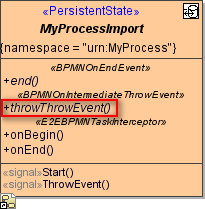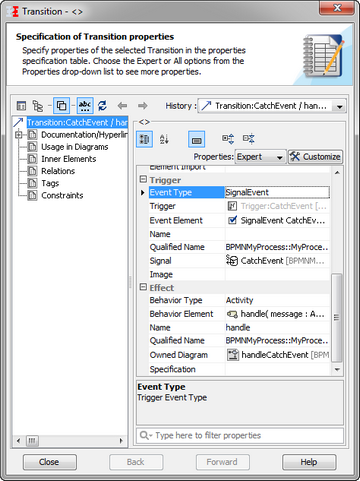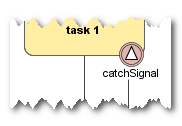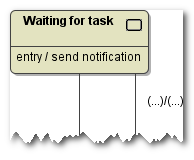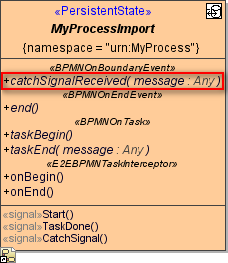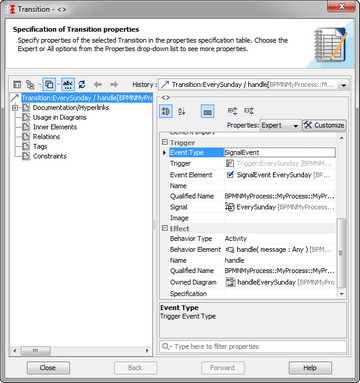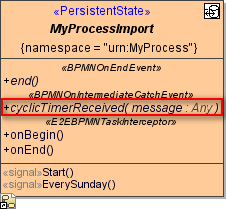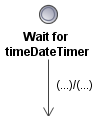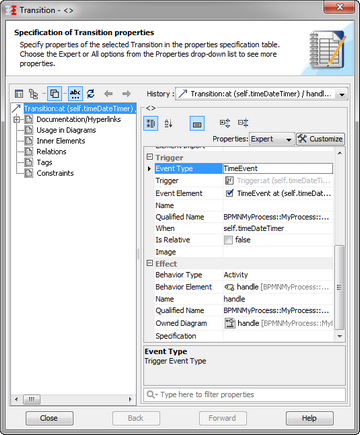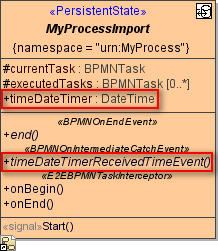An intermediate event is an event that might occur during the execution of a business process instance and will affect its course.
The semantic of some intermediate events might be two-folded as they can be used to catch or to throw an event. To make the distinction, a filled-in symbol can be used to indicate the sender semantic, while an unfilled one will denote a receiver one.
All types of intermediate catch events are mapped to a state triggered by a signal (see chapter Throw Intermediate Events et seq.), except a timeDate timer which is triggered by a time event (see chapter Intermediate TimeEvents et seq.).
Intermediate Throw events
|
BPMN shape |
BPMN description |
|---|---|
|
|
The picture shows a Signal Throwing Intermediate Event. |
|
UML representation |
UML description |
|---|---|
|
|
Throw events are mapped to states having an entry action that implements the throwing of a signal by calling an operation that sends a signal to self.
|
|
|
An overridable <<BPMNOnIntermediateThrowEvent>> operation is created. This operation is used by the handler mentioned above |
In contrast to intermediate catch events, in BPMN intermediate throw events on borders are not allowed (see Catch Intermediate Boundary Events).
Intermediate Catch Events
|
BPMN shape |
BPMN description |
|---|---|
|
|
The picture shows an Intermediate Catch Event without a trigger, but any triggers such as Error, Signal, etc. are mapped the same way. |
|
UML representation |
UML description |
|---|---|
|
|
An intermediate catch event is mapped to a state named Wait for <Intermediate Event Name> and is stereotyped with <<BPMNIntermediateCatchEvent>>.
|
|
|
A signal event triggers the catch of the intermediate event and invokes a handler where the modeler can implement any handling if needed. The signal name is derived from the event name. |
|
|
Furthermore, an overridable <<BPMNOnIntermediateCatchEvent>> operation is created. This operation is used by the handler mentioned above. |
Catch Intermediate Boundary Events
|
BPMN shape |
BPMN description |
|---|---|
|
|
Intermediate catch events might be specified on the border of a BPMN element, i.e. to abort a sub-process or a task before it has finished. |
|
UML representation |
UML description |
|---|---|
|
|
In this case a state Wait for <Intermediate Event Name> is not necessary; the signal event is generated directly at the UML element that was created from the BPMN element. |
|
|
The signal event triggers the catch of the intermediate event and invokes a handler activity. The signal name is derived from the event name. |
|
|
Furthermore, an overridable <<BPMNOnBoundaryEvent>> operation is created. This operation is used by the handler mentioned above. |
Intermediate Time Events
A specific time-date or a specific cycle (e.g., every Sunday) can be set that will trigger the event. The mapping of Intermediate Time Events depends, whether it is a time-date, a cyclic or a duration event.
Cyclic Timer Event
|
BPMN shape |
BPMN description |
|---|---|
|
|
A Cyclic Timer Event is defined by specifying the tagged value timeCycle on a Timer Catching Intermediate Event.
|
|
UML representation |
UML description |
|---|---|
|
|
Time events are mapped to <<BPMNIntermediateCatchEvent>> states named Wait for <Intermediate Event Name>.
|
|
|
A UML signal event triggers the occurrence of the event and invokes a handler where the modeler can implement any handling if needed.
|
|
|
An overridable <<BPMNOnIntermediateCatchEvent>> operation is created. This operation is used by the handler mentioned above. |
Time-Date Timer Event
|
BPMN shape |
BPMN description |
|---|---|
|
|
A Time-Date Timer Event is defined by specifying the tagged value timeDate on a Timer Catching Intermediate Event. |
The value does not need to have any syntax as it will be just used as documentation in the target UML.
|
UML representation |
UML description |
|---|---|
|
|
Time events are mapped to <<BPMNIntermediateCatchEvent>> states named Wait for <Intermediate Event Name>.
|
|
|
In contrast to the cyclic timer, for time date timer an absolute UML time event triggers the end of the waiting time and invokes a handler where the modeler can implement any handling if needed. |
|
|
Additionally, a UML attribute of type dateTime holding the event time is created. The name of the attribute is derived from the event name. This attribute is used in the event condition in the state diagram and the value has to be set by the modeler (e.g. during process creation).
|
Duration Timer Event
|
BPMN shape |
BPMN description |
|---|---|
|
|
A Duration Timer Event is defined by specifying the tagged value timeDuration on a Timer Catching Intermediate Event. The timeDuration value is used to set the default duration in seconds in the UML model if it is a comma separated list of weeks, days, hours, minutes, and seconds. For example, "1 hour, 10 minutes, 30 seconds" is translated into a UML default value of 4230 seconds. It is also possible to prefix this value with the keyword after. For instance, "after 1 hour, 10 minutes, 30 seconds" evaluates to 4230 seconds as well.
If the timeDuration cannot be translated into seconds, the UML default value is set to the lowest positive integer value - namely 1 second. |
|
UML representation |
UML description |
|---|---|
|
|
Time events are mapped to <<BPMNIntermediateCatchEvent>> states named Wait for <Intermediate Event Name>.
|
|
|
A UML time event triggers the occurrence of the event and invokes a handler where the modeler can implement any handling if needed. |
|
|
The persistent state class of the process contains an attribute holding the time duration. The value of this attribute must be set by the modeler, e.g. at process creation. |



